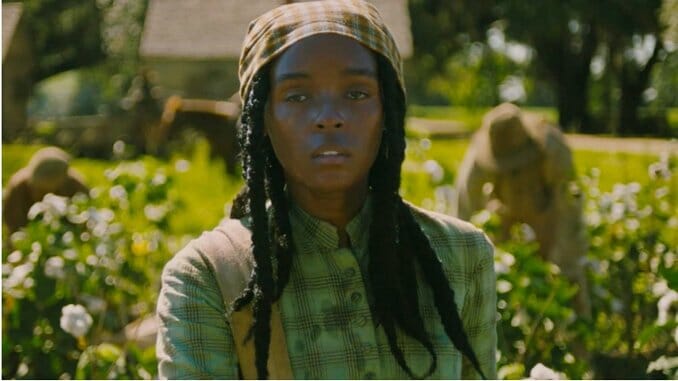The first step anyone should make to prepare for Gerard Bush and Christopher Renz’s COVID-delayed feature debut, Antebellum, is to shove all thoughts of Octavia Butler’s Kindred out of their minds. Antebellum, marketing flimflam aside, is not Kindred. Knowing as much allows viewers to better appreciate the former on its own dreadful terms while leaving them pining for the latter. Butler’s tale of time travel and American slavery pays fundamental attention to narrative in tandem with plot, and actually bothers to consider its characters as human beings and build a structure around its basic conceit. It’s a closed circuit and a complete work.
Striking a lopsided contrast, Antebellum is all plot, all the time, with little narrative and less character binding the production together. The film is a pile of brutal incidents absent of heart and compassion, a playlist of the worst torments Black people, Black women especially, endured in the American South before being briefly and loosely freed by the end of the Civil War. Bush and Renz coat Antebellum with the gloss of prestige filmmaking and the creeping discomfort of psychological horror, shooting for an aesthetic in the same neighborhood as 12 Years a Slave but bordering the zip code of films like Hostel. Whether they meant to check out real estate in The Village as well or not, that’s closer to where Antebellum actually ends up. But ultimately, shock value is all the movie has.
Antebellum opens with a slick tracking shot totaling to about eight minutes in length, taking the viewer on a tour through a plantation from the Big House to the slaves’ quarters, observing as companies of Confederate soldiers march their way around the property while men and women in bondage labor around them. A man in a slave collar and a woman in a stunning green dress are separated by soldiers on horseback, and when she makes a break for it, she ends up lassoed on the ground and dead from a headshot. Drilling down further from the cruel granularity of this sequence, the movie turns to Eden (Janelle Monáe) as she’s beaten and branded by her master, credited as “Him” (Eric Lange). He forces her to accept her name and speak it aloud, as if rechristening her as a slave. She’s clearly new around here.
For the next half hour, Antebellum engages in slavery free association games, concocting one example of barbarity after another before abruptly transitioning to the present, where Eden is actually Veronica Henley, a sociologist, PhD, and activist out on the road promoting her new book. She has a daughter, Kennedi (London Boyce), and a husband, Nick (Marque Richardson), and combined they’re a fashionable, warm and heart-meltingly cute family unit—she the power momma, he the picture-perfect modern husband, they the best example of functional parenting. (Kennedi is so adorable it might make your head explode.) In this stretch of Antebellum, Bush and Renz cover the particulars by which Veronica tumbled down a 160-year-old rabbit hole and woke up in chains, kidnapped through the space-time continuum into the worst circumstances possible, except that there’s a twist on the twist, and this takes the film from merely a mediocrity to an embarrassment.
There’s no “there” there in Bush and Renz’s script. None of the characters, either the slavers or the enslaved, have personalities. The writing has no stakes. Beyond Veronica’s obvious need to liberate herself from the plantation, Antebellum lacks dramatic impetus. It exists merely to reenact historical atrocities with no context given, because portraits of Black bodies under duress are the ones most often codified by Hollywood as “important,” even in the post-Moonlight phase of the contemporary Black American cinematic renaissance. In Antebellum, cinematic pomp is the key technique, whether in up-close slow-mo photography of Monáe riding to victory on horseback or walking with her back to the crematorium she’s set ablaze with a handful of Confederate officers trapped inside. Images like these should provide a sense of horror-fueled catharsis as the protagonist finally triumphs over the monster, but the film’s opportunism renders them cheap and hollow.
Like well-intentioned protest songs written on a whim to send a message better-suited for social media bulletins, Antebellum capitalizes on misery without thinking the misery through. Bush and Renz supersaturate their work with text upon text, leaving nothing to the imagination and robbing the film not only of value to cultural discourse but value as entertainment. If languid, sloppy craftsmanship is one strike, the film’s artificial timeliness can serve as strikes two and three. Antebellum spotlights the racist horrors of the present as a product of the past, but maybe Bush and Renz should’ve let those horrors stay there.
Directors: Gerard Bush, Christopher Renz
Writers: Gerard Bush, Christopher Renz
Starring: Janelle Monáe, Eric Lange, Jack Huston, Jena Malone, Kiersey Clemons, Marque Richardson, Gabourey Sidibe, Tongayi Chirisa, Robert Aramayo
Release Date: September 18, 2020
Bostonian culture journalist Andy Crump covers the movies, beer, music, and being a dad for way too many outlets, perhaps even yours. He has contributed to Paste since 2013. You can follow him on Twitter and find his collected work at his personal blog. He’s composed of roughly 65% craft beer.
